
Apantesis is a genus of tiger moths in the family Erebidae first described by Francis Walker in 1855. They are found in North and Central America.
Compacta is a genus of moths of the family Crambidae. The genus was erected by Hans Georg Amsel in 1956.
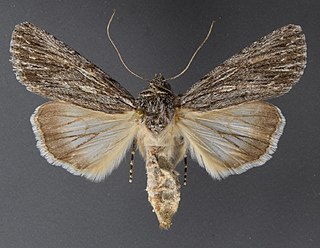
Sympistis major is a moth of the family Noctuidae first described by Augustus Radcliffe Grote in 1881. It is widely distributed in the Pacific Northwest of North America. It was formerly known as Oncocnemis riparia major, a subspecies of Oncocnemis riparia, but was elevated to species level as Oncocnemis major in 1999 and transferred to the genus Sympistis in 2008.
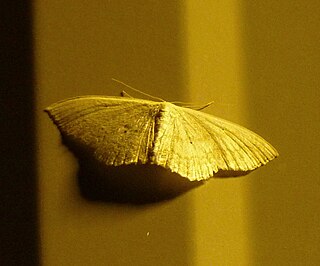
Lomographa glomeraria, the gray spring moth, is a moth of the family Geometridae. The species was first described by Augustus Radcliffe Grote in 1881. It is found in eastern North America, including Alabama, Arkansas, Illinois, Indiana, Maryland, Massachusetts, Michigan, Oklahoma, Ontario, Pennsylvania and Tennessee.

Acrolophus mora, the dark acrolophus, is a moth of the family Acrolophidae. It was described by Augustus Radcliffe Grote in 1881. It is found in North America, including Florida, Georgia, Illinois, Kentucky, Maryland, Massachusetts, Mississippi, New Hampshire, New York, North Carolina, Ohio, Quebec, South Carolina, Tennessee, Virginia and West Virginia.
Pseudohemihyalea labecula, the freckled glassy-wing, is a moth in the family Erebidae. It was described by Augustus Radcliffe Grote in 1881. It is found in the United States in southern Nevada, Utah, from Colorado to Arizona, New Mexico and western Texas.

Chrysendeton medicinalis, the bold medicine moth, is a moth in the family Crambidae. It was described by Augustus Radcliffe Grote in 1881. It is found on North America, where it has been recorded from Alabama, Florida, Georgia, Illinois, Indiana, Kentucky, Maryland, Mississippi, North Carolina, Ohio, Pennsylvania, South Carolina, Tennessee, Texas and West Virginia.
Agriphila undata is a moth in the family Crambidae. It was described by Augustus Radcliffe Grote in 1881. It is found in North America, where it has been recorded from California.
Loxostege annaphilalis is a moth in the family Crambidae. It was described by Augustus Radcliffe Grote in 1881. It is found in North America, where it has been recorded from south-western California, from Kern County to San Diego County.
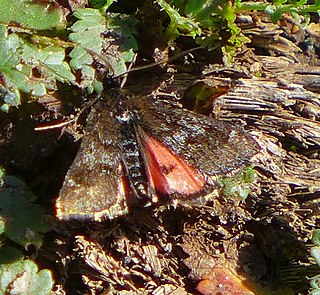
Pyrausta dapalis is a moth in the family Crambidae. It was described by Augustus Radcliffe Grote in 1881. It is found in western North America, where it has been recorded from California and Oregon.

Pyrausta lethalis, the lethal pyrausta moth, is a moth in the family Crambidae. It was described by Augustus Radcliffe Grote in 1881. It is found in North America, where it has been recorded from California to southern Nevada, southern Arizona and Texas.
Compacta hirtalis is a moth in the family Crambidae. It was described by Achille Guenée in 1854. It is found from the southern United States, where it has been recorded from Arizona and Texas, south through Central America to South America, including French Guiana and Brazil.
Desmia subdivisalis is a moth in the family Crambidae. It was described by Augustus Radcliffe Grote in 1871. It is found in the West Indies, Mexico and the United States, where it has been recorded from Florida to New Mexico, Illinois, Maryland and California.

Baileya australis, the small baileya moth, is a moth of the family Nolidae. The species was first described by Augustus Radcliffe Grote in 1881. It is found in North America, where it has been recorded from Quebec and New York to Florida, west to Texas, north to North Dakota and Ontario.
Eulepte anticostalis is a moth in the family Crambidae. It was described by Augustus Radcliffe Grote in 1871. It is found in North America, where it has been recorded from Florida to North Carolina and west to Texas. It is also found on Puerto Rico.
Mecyna submedialis, the orange-toned mecyna moth, is a moth in the family Crambidae. It was described by Augustus Radcliffe Grote in 1876. It is found in North America, where it has been recorded from Ontario and Michigan, south to Florida and west to Arkansas. It has also been recorded from Alberta.

Udea turmalis is a moth in the family Crambidae. It was described by Augustus Radcliffe Grote in 1881. It is found in North America, where it has been recorded from Alberta, Arizona, British Columbia, California, Colorado, Idaho, Manitoba, Montana, Nevada, New Mexico, Utah and Washington.
Udea vacunalis is a moth in the family Crambidae. It was described by Augustus Radcliffe Grote in 1881. It is found in North America, where it has been recorded from California.
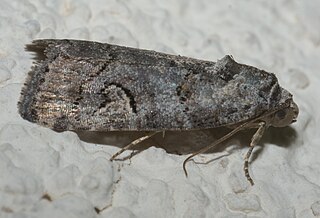
Triocnemidina is a subtribe of owlet moths in the family Noctuidae. There are about 16 genera and at least 30 described species in Triocnemidina.
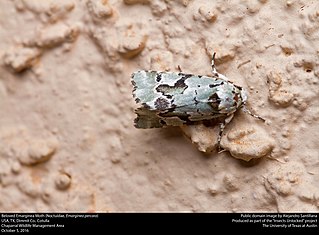
Psaphidini is a tribe of owlet moths in the family Noctuidae. There are at least 40 genera and at least 90 described species in Psaphidini.











